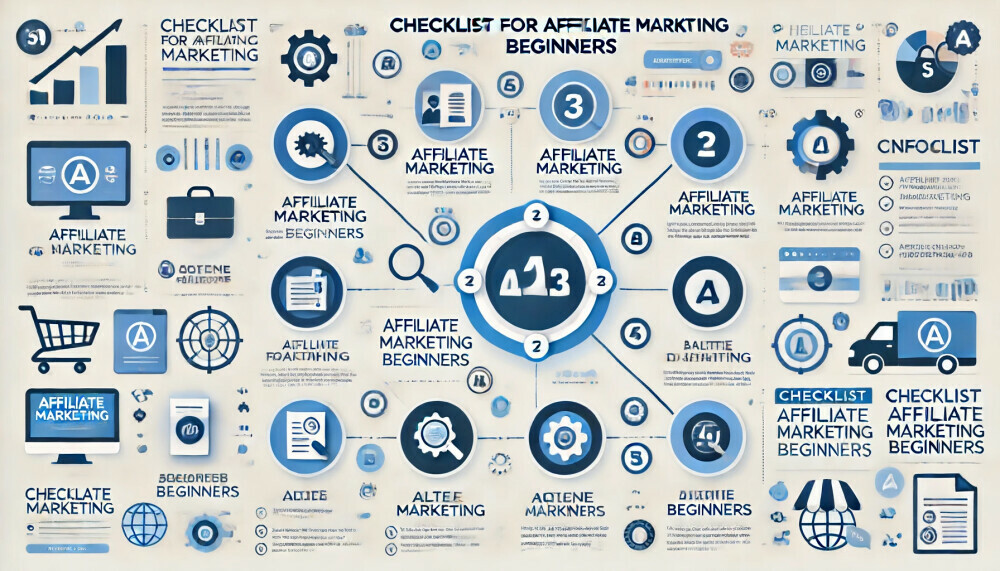
Getting into affiliate marketing can be both exciting and daunting. As a beginner, having a clear roadmap can make the journey smoother and more efficient. Here’s a detailed checklist to help you get started on the right foot.
 1. Define Your Niche
1. Define Your Niche
- Identify Your Interests and Expertise: Start with topics you’re passionate about or knowledgeable in. This will make content creation easier and more enjoyable.
- Research Market Demand: Use tools like Google Trends, Keyword Planner, and market research reports to ensure there’s a substantial audience interested in your niche.
- Evaluate Competition: Analyze existing content in your chosen niche to understand the competition. Aim for niches with moderate competition where you can add unique value.
 2. Choose the Right Affiliate Programs
2. Choose the Right Affiliate Programs
- Relevance to Your Niche: Select programs that align closely with your niche. Promoting relevant products increases the likelihood of conversions.
- Commission Structure: Compare commission rates across different programs. Look for programs offering a balance between competitive rates and achievable sales targets.
- Program Reputation: Opt for well-established and reputable affiliate programs. Check reviews and payment histories to avoid scams.
- Cookie Duration: Longer cookie durations give you more time to earn commissions from referred traffic. Favor programs with at least 30-day cookies.
3. Set Up Your Website or Blog
- Domain Name: Choose a memorable and niche-relevant domain name. Keep it short, easy to spell, and reflective of your brand.
- Web Hosting: Select a reliable hosting provider. Look for features like uptime reliability, speed, and customer support.
- Content Management System (CMS): WordPress is a popular choice for its flexibility and extensive plugin support.
- Website Design: Invest in a clean, user-friendly design. Ensure your site is mobile-responsive and easy to navigate.
 4. Create High-Quality Content
4. Create High-Quality Content
- Content Types: Diversify your content with blog posts, reviews, tutorials, and comparison articles. Video content and podcasts can also enhance engagement.
- SEO Optimization: Conduct keyword research and optimize your content for search engines. Focus on long-tail keywords to capture more targeted traffic.
- Value-Driven Content: Provide actionable insights, solve problems, and offer genuine value to your audience. High-quality content builds trust and authority.
- Regular Updates: Consistently update your site with fresh content to keep your audience engaged and improve SEO rankings.
5. Build and Grow Your Audience
- Email Marketing: Start building an email list from day one. Offer lead magnets like eBooks, checklists, or exclusive tips in exchange for email sign-ups.
- Social Media Presence: Leverage platforms like Facebook, Instagram, Twitter, and LinkedIn to promote your content and engage with your audience.
- Community Engagement: Participate in niche-related forums, groups, and discussions. Share your expertise and direct traffic back to your site.
- Guest Posting: Write guest posts for reputable sites in your niche. This can drive traffic and improve your site’s authority.
6. Monetize Your Traffic
- Affiliate Links Placement: Strategically place affiliate links within your content. Ensure they are contextually relevant and not overly intrusive.
- Call-to-Action (CTA): Use compelling CTAs to encourage clicks on your affiliate links. Make your CTAs clear and enticing.
- A/B Testing: Continuously test different elements of your pages (headlines, CTA buttons, link placements) to optimize for higher conversions.
- Track Performance: Use tools like Google Analytics and affiliate dashboards to track your performance. Identify what’s working and refine your strategy accordingly.
7. Compliance and Transparency
- Disclosure: Always disclose your affiliate relationships clearly. This builds trust with your audience and ensures compliance with FTC regulations.
- Privacy Policy: Include a comprehensive privacy policy on your site, detailing how you collect and use visitor data.
- GDPR Compliance: If you have visitors from the EU, ensure your site complies with GDPR regulations regarding data protection and privacy.
8. Continuous Learning and Adaptation
- Stay Updated: Affiliate marketing trends and algorithms change frequently. Stay informed through blogs, podcasts, webinars, and industry news.
- Analyze Competitors: Regularly analyze your competitors’ strategies. Learn from their successes and failures to improve your approach.
- Feedback Loop: Encourage feedback from your audience and affiliates. Use this feedback to improve your content and strategies.
- Invest in Education: Consider investing in affiliate marketing courses, conferences, and mentorships to sharpen your skills and stay ahead of the curve.
Conclusion
 Starting in affiliate marketing requires careful planning and consistent effort. By following this checklist, you’ll establish a solid foundation for your affiliate marketing business. Remember, success doesn’t happen overnight. Stay patient, keep learning, and adapt to changes in the industry to maximize your earnings potential. Happy marketing!
Starting in affiliate marketing requires careful planning and consistent effort. By following this checklist, you’ll establish a solid foundation for your affiliate marketing business. Remember, success doesn’t happen overnight. Stay patient, keep learning, and adapt to changes in the industry to maximize your earnings potential. Happy marketing!
If you want to explore more in affiliate marketing, check out Wealthy Affiliate! It is where I learned how to make extra money.

